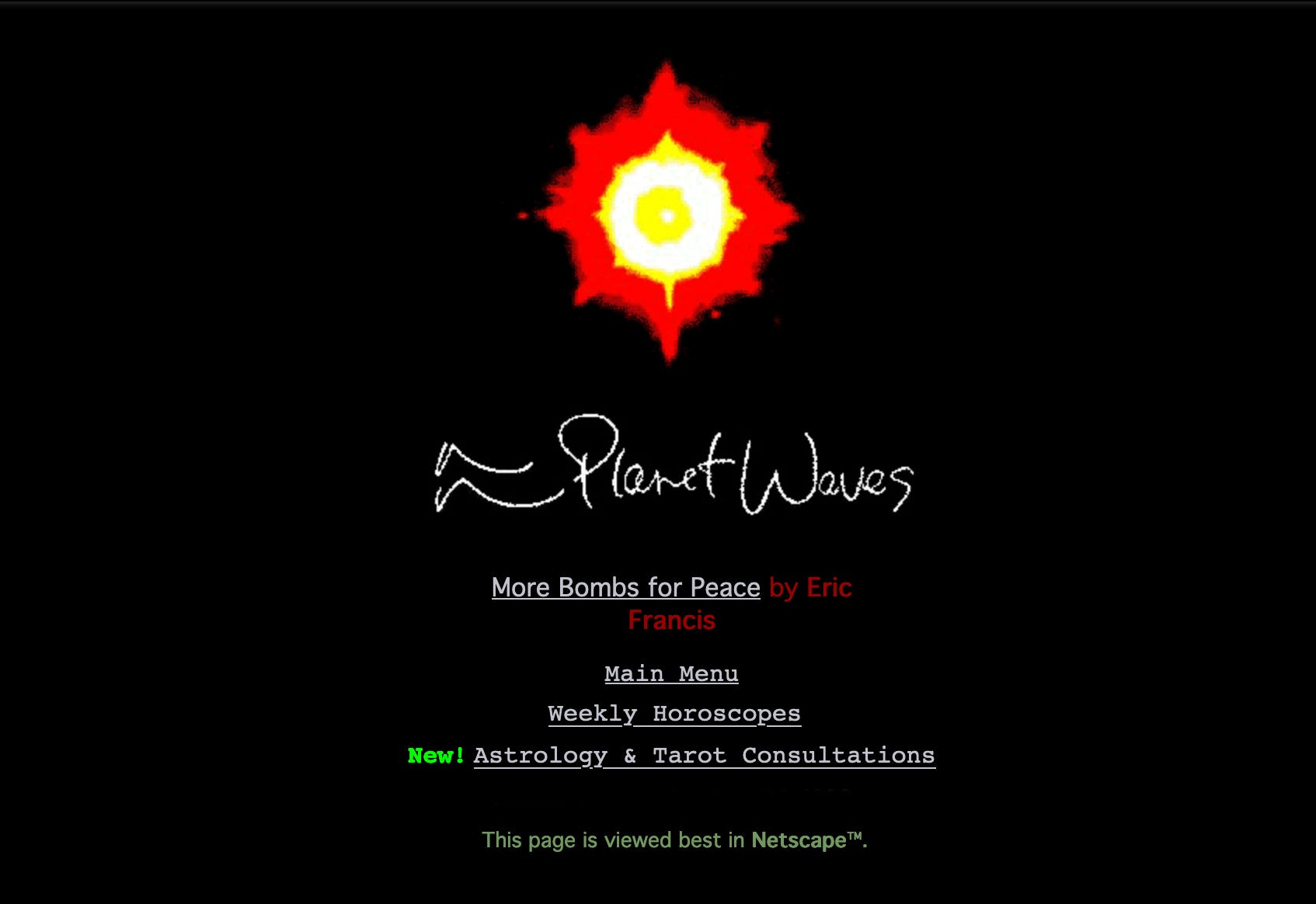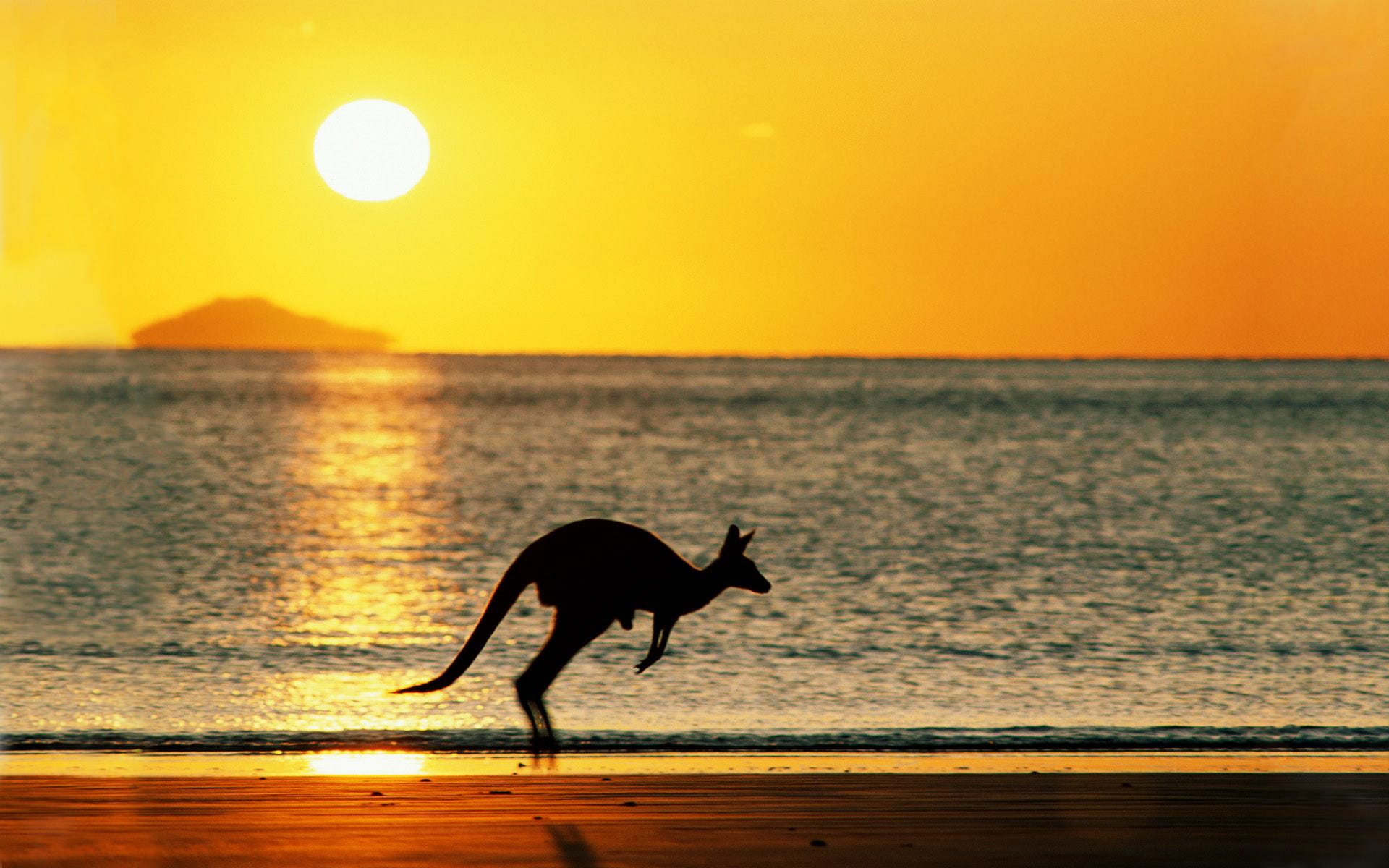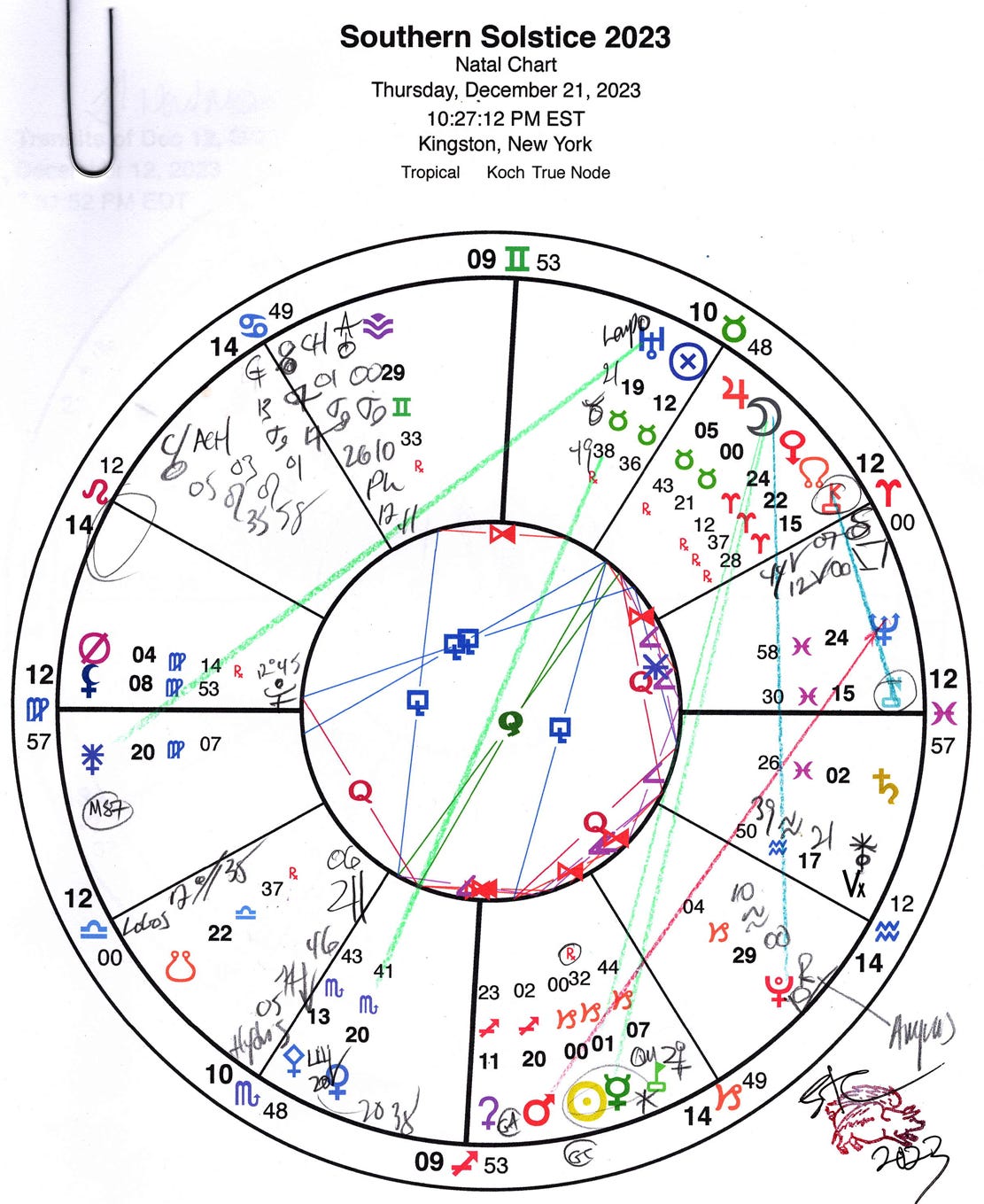
Dear Friend and Reader:
Southern solstice has arrived. As of Thursday night, Planet Waves has been published continuously for 25 years. I posted the first version of the website on the eve of the winter solstice in 1998, from my friend Neal McDonough’s home in Ho-Ho-Kus, New Jersey, with the help of Keiko Ito.
(Our 20th anniversary as a company was this past July. Both charts were chosen to emphasize the cardinal points.)
I am currently fully involved in Somewhere In Between, your 2024+ readings. Currently, all 12 signs are at pre-sale pricing. We will soon introduce a two-sign option. All purchases include instant access to two prior video readings (Dharma and Pluto in a Strange Land), one prior audio reading (All of Us Here) and one prior written reading (Aquarian Era) to keep you busy while I am working. These readings get better with time.
As for today’s solstice: the Sun’s rays are now the most direct over the Tropic of Capricorn, a bit more than 23 degrees south of the Equator, meeting the tropic at a right angle. Sources confirm that the days are at their longest in the Southern Hemisphere and at their shortest in the Northern Hemisphere.
This effect — known as the seasons — occurs because the Earth’s axis of rotation (spinning like a top) is tilted at 23 degrees from the plane of its orbit around the Sun. As the Sun orbits, the angle at which its rays touch the Earth is a little different every day. Hence the length of days and nights differs each day.

Long Days, Short Nights in the Southern Hemisphere
Our bureaus in the Southern Hemisphere report that the days are at their longest and it is indeed summertime and very sunny.
“We are house-sitting and the bedroom window faces the sunrise, which is deeply annoying since it hits me in the face at around 5 am. Sun goes down around 8h30pm at the moment” our South African bureau chief Jeremy Nell reported today.
We have confirmed his account with other sources, including Alison Primrose, telegraph operator at the Terra Australis bureau.
“Yes. I can confirm that we appear to be experiencing the usual phenomena of a bloody hot summer, including higher temperatures, thick humidity, torrential rain and the odd cyclone. Daylight hours have stretched out to fourteen hours or so and the nights are indeed quite short at present.”

Short Days, Long Nights in the Northern Hemisphere
Up here in the Northern Hemisphere the days are currently very short, nights are long, it’s chilly out, and the Sun when visible is always low in the sky.
We just received an urgent cable from our Yellowknife bureau in the Northwest Territories of Canada: “PRETTY DAMNED DARK UP HERE. SUN RISES 10 AM SETS 3 PM. COLD OUT LOTTA SNOW. HAVE HOT COCO. SNUGGLING WITH HUSKIES.”
That’s the most we’ve heard from them in a while; there is not much news up there, though they are working on an interview with a yeti.
Imagine if you could see the Earth from space as the seasons changed. It would look like a green pulse rising above the equator, reaching nearly to the northern polar region after the Aries Equinox and sinking below it after the Libra Equinox.
This pulse may be one of the things that makes life on our planet possible — the constantly changing tide of warmth and light that keeps things moving and fresh.

Sun Enters Capricorn
The Sun’s rays currently making a 90-degree angle to the Tropic of Capricorn means that the Sun has “entered” the tropical sign Capricorn. Summer has begun in the south and winter in the north.
The tropical zodiac — the one we in the West use — is an internal frame of reference on our planet, having nothing to do with the stars or constellations.
The tropical zodiac is based on the seasons and divides the apparent path of the Sun into 12 slices called “signs.” (That word does not exist in ancient Greek and it’s not clear what the equivalent was.) Each season is made of three signs — one cardinal, one fixed and one mutable, in that order. During the mutable sign, one season gives way to the next.
While the signs loosely line up with constellations that have the same name, the constellations are irrelevant to how seasonal time (or astrology) is measured. The constellations are vastly uneven in size, they often overlap, and their location (from our viewpoint on Earth) shifts over the centuries with the Earth’s wobble.
As the planet rotates it spins like a top that also wobbles just a little (once every 25,000 years or so), which creates the illusion that the constellations are gradually drifting. This is the “precession of the equinoxes,” associated with what we think of as the coming Age of Aquarius.
To solve this very problem, the tropical zodiac — the internal reference frame based on the seasons — was invented. Astrology at its most basic is a practical tool (rather than a mystical or metaphysical one). The primary reason for keeping track of the seasons — meaning the solar cycle — was to grow food more effectively. That also accounts for the development of written language.

What the Moon and Planets are Doing
Within the backdrop of time measured by the solar cycle (the year, the seasons), the Moon and the planets move around in their own cycles. When the Sun reaches solstice Thursday at 10:27 pm EST, the Moon will be in Taurus, right near Jupiter (this will be visible anywhere you can see the Moon).
The Moon is approaching full phase, which occurs Tuesday, Dec. 26 at 7:33 pm EST. So while we may not have a white Christmas (especially if you’re in the Southern Hemisphere), we will definitely have a bright one.
As of solstice, Mercury is retrograde and about to form its interior conjunction with the Sun. This is Mercury passing between the Earth and the Sun, overtaking the Earth in its orbit, which happens about three times a year.
The Mercury-Sun conjunction is exact in Capricorn at 1:44 pm EST on Friday, Dec. 22. So we have a cluster of three events in a short time: Solstice, Full Moon and Mercury conjunct the Sun. Mercury retrogrades back into Sagittarius Saturday at 1:35 am. So this indicates rather busy days, and some pressure; keep your head.
Mars is also in Sagittarius, Venus is in Scorpio, and Pluto moves into the last degree of Capricorn before its ingress into Aquarius on Jan. 20. Jupiter and Saturn still exist.
With love,






Bon 20e anniversaire!